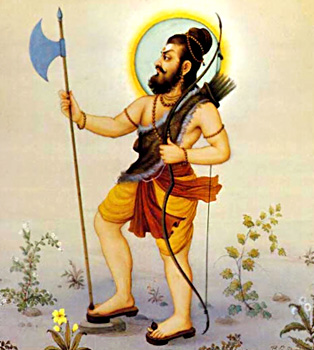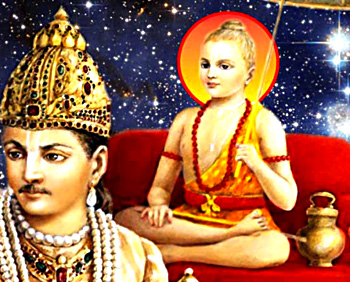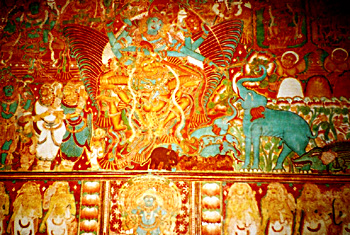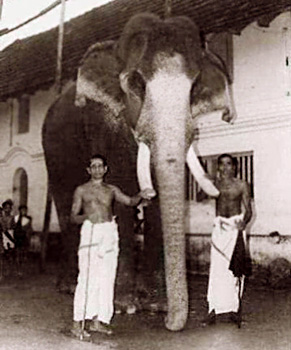 Legends of Kerala persist with regard to the origin of the state and its people. The state of Kerala is a land of various facets. The land is rich in natural bounties including splendid landscapes as well as the celebration of culture and piety of the people of the state. It is of no surprise that several legends and myths seep in the form of folklore or religious episodes have become a part and parcel of the inhabitants of the land. There are scores of tales which are often narrated to the children of this state in order to instill a feeling of pride for their origin and instill a moral and religious value by assimilating their lessons. Like several other cultures, these fables of Kerala are chiefly founded on religious themes and devotees and deities.
Legends of Kerala persist with regard to the origin of the state and its people. The state of Kerala is a land of various facets. The land is rich in natural bounties including splendid landscapes as well as the celebration of culture and piety of the people of the state. It is of no surprise that several legends and myths seep in the form of folklore or religious episodes have become a part and parcel of the inhabitants of the land. There are scores of tales which are often narrated to the children of this state in order to instill a feeling of pride for their origin and instill a moral and religious value by assimilating their lessons. Like several other cultures, these fables of Kerala are chiefly founded on religious themes and devotees and deities.
Legend of Parasurama
Parasurama was the renowned warrior sage and the son of Maharishi Jamadagni and his virgin wife Renuka. There is a belief that the once peace loving ashram or shelter of the great Sage Jamadagni was overwhelmed by King Kartavirya Arjuna along with his Kshatriya army who desired to abduct by force the divine cow of Jamadagni, Surabhi. When the sage denied giving away his loved cattle, the cruel Kshatriya king demolished his hermitage and cruelly killed Jamadagni. The sage`s son, Parasurama who was not present at the place that very moment, returned to witness the devastations caused by the cunning King and his Kshatriya army and found his mother in a sorrowful state. Unable to bear the agony, Parasurama`s mother struck twenty one blows to her own chest. Ignited by the fire of revenge, Parasurama took a frightening vow and swore to eliminate the race of the Kshatriyas from the world. Thus, he left out to gain knowledge of some of the divine arms and weapons by undertaking extreme penance to please the Lord Shiva and in which he got success.
 Parasurama then massacred the Kshatriyas twenty one times, until he had wiped them from the earth. Doubtless this is a mythical explanation of the fact that the chiefly caste of the Aryan invaders appears to have been almost exterminated in the series of civil wars condensed into the story of the great slaughter at the battle of Kurukshetra in the Mahabharata; later Kshatriyas, such as the Rajputs, seem to have been elevated from the ranks of invading warrior races like the Sakas and the Huns, who gradually lost their identity in Hindu society. But for the people of Kerala the important part of the story of Parasurama is a kind of pendant added later by the local Nambudiri Brahmins. This massacre however influenced him so much that with the advice of learned sages he gave up the land he won to the Brahmins. He again undertook severe austerities and asked for the help of Bhumidevi, the Goddess of Earth and Lord Varuna who is regarded as the God of the Oceans. By their divine blessings Parasurama went on to Kanya Kumari and from there, facing towards the north, he threw his battle-axe or Parasu. To show his admiration, Varuna retreated to the place where the battle-axe lay and this place is called Parasurama`s land presently in the Indian state of Kerala.
Parasurama then massacred the Kshatriyas twenty one times, until he had wiped them from the earth. Doubtless this is a mythical explanation of the fact that the chiefly caste of the Aryan invaders appears to have been almost exterminated in the series of civil wars condensed into the story of the great slaughter at the battle of Kurukshetra in the Mahabharata; later Kshatriyas, such as the Rajputs, seem to have been elevated from the ranks of invading warrior races like the Sakas and the Huns, who gradually lost their identity in Hindu society. But for the people of Kerala the important part of the story of Parasurama is a kind of pendant added later by the local Nambudiri Brahmins. This massacre however influenced him so much that with the advice of learned sages he gave up the land he won to the Brahmins. He again undertook severe austerities and asked for the help of Bhumidevi, the Goddess of Earth and Lord Varuna who is regarded as the God of the Oceans. By their divine blessings Parasurama went on to Kanya Kumari and from there, facing towards the north, he threw his battle-axe or Parasu. To show his admiration, Varuna retreated to the place where the battle-axe lay and this place is called Parasurama`s land presently in the Indian state of Kerala.
Legend of Mahabali, the Onam festival
Onam is the year`s great fertility rite, the ceremony of gratitude for the never-failing fruits of a tropical climate, but it also a festival that reenacts one of the most important legends of the Malayali people. On the eve of Thiru Onam, the second day of the festival, ziggurat-like structures of flowers are placed in the entrances to Keralan houses; these are intended to welcome, on his annual return the following morning from the under world, the legendary King Bali or Mahabali, who ruled over Kerala in the golden age before caste existed, when all men were equal no man was poor, and there was neither theft nor dread of thieves.
 There is a belief in Kerala that the King Mahabali was the demon ruler and his capital state was Kerala. Even if he was an Asura, Mahabali possessed tremendous virtues. The king was generous, honest, judicious, kind and benevolent. King Mahabali was highly ambitious and after winning the entire earth and the netherworlds, the king tried for the Swarga or the celestial realm. There, he dethroned Indra from Swarga and announced himself as the king. The Devas under the leadership of Indra went to Aditi who gave them the suggestion to go to Lord Vishnu. Thus, Lord Vishnu decided to get a human form in order to curb King Mahabali`s increasing superciliousness and give Indra his domain.
There is a belief in Kerala that the King Mahabali was the demon ruler and his capital state was Kerala. Even if he was an Asura, Mahabali possessed tremendous virtues. The king was generous, honest, judicious, kind and benevolent. King Mahabali was highly ambitious and after winning the entire earth and the netherworlds, the king tried for the Swarga or the celestial realm. There, he dethroned Indra from Swarga and announced himself as the king. The Devas under the leadership of Indra went to Aditi who gave them the suggestion to go to Lord Vishnu. Thus, Lord Vishnu decided to get a human form in order to curb King Mahabali`s increasing superciliousness and give Indra his domain.
The Lord Vishnu is deputed to save the Brahminical deities from this titanic magician, and he assumes the form of the pathetically ugly and comical dwarf Vamana, who one day appears before Bali as a holy beggar and asks a boon - the gift of as much land as he can cover in three paces. When Bali unsuspiciously agrees, Vamana begins to stride, and even as he makes the first step he grows into a being so gigantic that in his three paces he encompasses the whole earth, and the demon King Bali is forced to retreat to the infernal region, the only kingdom that is left to him.
Elephants, Legend of Kerala
 People of Kerala not only pray god but they also worship animals. There are tales of pachyderm devotees very common in the state of Kerala which are narrated before children create in them a sense of religiousness from a tender age. Guruvayoor Keshavan and Gajendra Moksham are the two most renowned legends of the state. Guruvayoor Keshavan and Gajendra are among the most prominent examples of illustrious devotee elephants whose reverence and devotion towards the Lord is much higher than those of the human beings.
People of Kerala not only pray god but they also worship animals. There are tales of pachyderm devotees very common in the state of Kerala which are narrated before children create in them a sense of religiousness from a tender age. Guruvayoor Keshavan and Gajendra Moksham are the two most renowned legends of the state. Guruvayoor Keshavan and Gajendra are among the most prominent examples of illustrious devotee elephants whose reverence and devotion towards the Lord is much higher than those of the human beings.
Gajendra Moksham
Gajendra Moksham is the most celebrated elephant, as per legends, its cries to get help even brought the Lord Vishnu from his heavenly abode to save the animal. Even if this tale is set in Kapisthalam, the Tamil Nadu temple, this story happens to be the centre of several renowned mural paintings of Kerala and therefore is famous in each and very household of the Malayalis. The notable among the paintings is at the Krishnapuram Palace, which is situated on the way from Alleppey to Kollam, a place called Kayamkulam. This is one of the most spectacular and gigantic mural painting which belongs to the eighteenth century and it is also known to be the oldest in the area.
Guruvayoor Keshavan:
Apart from the murky mists of legend towards a present day legend, Guruvayoor Keshavan is the well-known and popular elephant devotee of the deity worshipped at Guruvayoor in the Indian state of Kerala. The Nilambur royal family gifted Keshavan at the age of ten to the Guruvayoonr temple. Till it lived, the elephant was highly devoted to the Lord Guruvayoorappan or Lord Krishna. Thus, Guruvayoor Keshavan was a grand and enforcing presence in the temple premises till it was alive. There is a belief that the elephant used to hold his head mush higher than his peers and demonstrated an uncanny insight or sixth sense. Numerous tales of this elephant`s love and devotion to the Lord are recited till date. Due to his intelligence, the authorities of the temple (Devaswom) gave him the title, "Gajarajan".
Ethical values, righteousness, morals, faith, humility and spirituality are all the virtues which are best taught at the time of early childhood. The innocent mind thus imbibes these great lessons of life in the best possible manner which helps them in the long run to construct a highly moral character and a personality. The legends of the state of Kerala are thus the best treasures of moral virtues which also includes the belief in truth and God and which the children of this state keep on hearing from different narratives from their elders.






